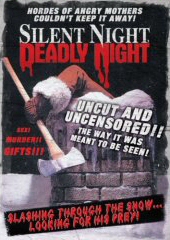
The gory and misanthropic grand-daddy of the killer Santa picture, taking its cue from the Amicus Tales From the Crypt segment "And All Through The House," Silent Night, Deadly Night has enjoyed (maybe not the best word!) a history easily as unfortunate as its titular slayer. Reviled, protested, and finally banned by parents and social groups more concerned with limiting free speech than in dealing with the poverty and violence that surrounded the nineteen eighties, this primitively effective exercise in mean spirited horror made the media watchdog's 'naughty list.' Shocking critics and audiences alike with its scathing portrayal of Catholic abuse and graphic excess, the films greatest offence was its depiction of Jolly Saint Nick as a murderous psychopath. Christmas horror films, particularly those focusing on psycho Santas, are a troubling (and paradoxical) contradiction of sentiments. Both celebrating and attacking the values of innocent fantasy that the holiday season whisks into our lives like newly fallen snow each December, the psycho-Santa flick subverts what we have been taught to love. This undeniably exploitative flick seeks to dismay on one hand and titillate on the other, exchanging the joys of the season with bare-chested babes writhing on deer antlers, severed heads rolling down snowy hills, and Nuns whose malignant devotion to 'discipline' nurtures hatred rather than piety. Re-released by Anchor Bay, this ballsy blood fest remains as disheartening and angry now as when it first appeared.
Injecting a wonderfully trashy concept with surprising psychological accuracy, Silent Night, Deadly Night is a sordid but undeniably literate (albeit minimalist) body count opus, arousing as much sympathy for its main character -- the damaged Billy - as it does repulsion. Written by Michael Hickey, the screenplay is intelligently depicts childhood trauma and the various social factors contributing to the final derangement of a young man that you can't help but pity. Likewise, we're encouraged to hate the system, in this case represented by the Catholic Church (represented by the Mother Superior) and commercialism. More effective yet is the sexual/psychological tension established, mirrored by Bill's slow-burn descent into madness. Warned by a demented grandfather that Santa murders bad children, little Billy Chapman barely escapes a psycho dressed as the jolly old Saint, and can only watch as his parents are brutally murdered. This grief is only compounded over the years at an orphanage where a heartless Nun instils within the child's psyche the belief that sex deserves violence, and that punishment is more crucial than forgiveness. A job at a retail store looks promising for Billy until he's forced to play Santa for the kiddies. On Christmas Eve, a deadly cocktail of alcohol and sexual frustration snaps Billy's grip on sanity and he travels the neighborhood punishing 'naughty' adults.
Tasty tonics for the over abundance of commercialized happiness shoved down our throats around every 25th of December, the Christmas horror film is, as a rule, misanthropic and bitter, challenging the syrupy sentiment which greeting card companies, churches, and mega stores wield every year for their own agenda. While the superlative Black Christmas (in many ways the template modern slasher) was and remains the pinnacle to which all festive frights aspire, the image of a weapon brandishing Santa Claus spelled cinematic gold to producers, appealing particularly to humbugs hankering to do some damage. Joyful Night, indeed! While the line of these festive frights is surprisingly long, including Christmas Evil (1980), To All A Goodnight (1980), and Don't Open 'Til Christmas (1984), Silent Night, Deadly Night took the final plunge into gleefully bad taste, warping forever the cherished cultural symbol of the child loving old Saint. An exploitative story told with sensationalistic fever, Silent Night, Deadly Night uses the false good cheer and traditional trimmings of the holiday as a distorted mirror with which to reflect the inherent darkness in mankind, exposing how impressionable the human animal is. The atmospheric flourishes of the holiday, juxtaposed with raw violence and brooding emotional intensity, sustain much of the suspense. More important than either of these elements is the gratuitous amount of blood spilled and skin exposed. This is exploitation gold, entertainment crafted for the express purpose of enthralling and disturbing. In this it succeeds admirably, leaving a dirty bruise on our emotions, a stink on our skin.
A simple re-release, Anchor Bay leaves this in your stocking with no new extras or enhancements. Featuring the same impressive anamorphic transfer from last time, the colors are primarily vivid and the picture clean -- that is, when the addition of uncut footage is inserted with it. This is acceptable, not overly distracting, and worthwhile for the gratuitous goodies it enables us to see. Audio is in clean, distortion free Mono.
Special features have been ported over from the last release, and include the well spoken if somewhat apologetic audio interview with director Charles E. Seller, Jr., a poster/photo gallery, and "Santa's Stocking of Outrage", where uninformed critics and drooling parents act as distasteful as they claim the movie to be.
Review by William Simmons
| Released by Starz/Anchor Bay |
| Region 1 - NTSC |
| Not Rated |
| Extras : |
| see main review |